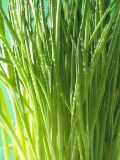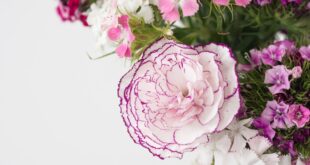Article By PA Cloar
Planting a basic herb garden is no supernatural feat. Especially if you choose chives plants as your path into herb gardening. I speak from experience. My bumbling, blunders and missteps still managed to deliver thriving emerald chives plants.
I admit a happy chance landed chives plants into my life some years ago. Yes, I stumbled into beginning my basic herb garden by planting chives plants aplenty! Usually people are led into planting an herb garden by their love of cooking with herbs. Nope. Not in my case. Although an avid novice gardener, herbs were totally lacking from my cooking. But, an encounter with chives plants in my herb garden changed all that. The entire experience drew me to introduce you to chives as an herb plant for your garden and share the darn useful discoveries gardening with chives herbs taught me.
Typically people think of chives as these dried up little green pieces that look like cuttings from your lawn. Sadly little taste survives in this dried version. Most of us get introduced to using chives as an herb simply as a condiment for a baked potato…sour cream with chives. Due to its past classification as a common household herb, the fascinating features of chives as a plant and herb have been much maligned. Here's what I unearthed as a beginner planting an herb garden when I somehow mistakenly ordered 9 chives plants, but intended to get only 1.
The Basics of Chives As A Plant In Your Herb Garden
Chives are part of the onion family but the flavour is much milder and more subtle. Until you've tasted fresh chives you won't believe the difference in taste from those dried up commercial counterparts you buy at the store! Chives grow in clumps, which is why they're always referred to as plural. The upright green shoots that grow from the clumps are really called the leaves of the plant.
 Growing chives is a dream for beginners in basic herb gardening. I'm prime proof of how easy it is. In fact, for ease of growing I put them in the category of daylilies because they're so indestructible no matter the amount of rain or scorching heat. I was clueless how to plant my chives plants (or any herb) in the garden when they arrived. Somehow they've survived in the clay soil of hot Kentucky summers for almost a decade now. You can even dig up their roots (actually little onion-like bulbs), divide them, and replant them just like daylilies! Although chives plants are best planted in a healthy mixture of soil, peat, sand and compost, my ignorance proves chives plants do well as long as they have plenty of sun and some water now and then.
Growing chives is a dream for beginners in basic herb gardening. I'm prime proof of how easy it is. In fact, for ease of growing I put them in the category of daylilies because they're so indestructible no matter the amount of rain or scorching heat. I was clueless how to plant my chives plants (or any herb) in the garden when they arrived. Somehow they've survived in the clay soil of hot Kentucky summers for almost a decade now. You can even dig up their roots (actually little onion-like bulbs), divide them, and replant them just like daylilies! Although chives plants are best planted in a healthy mixture of soil, peat, sand and compost, my ignorance proves chives plants do well as long as they have plenty of sun and some water now and then.
In my accidental adventure in herb garden planting, I discovered chives plants are perennial! That means, the plant dies back through the winter and sprouts new leaves in the spring. Perennials make a gardener's life far easier simply because they DO automatically emerge every year without my help. Also in the spring, the chives plant produces a bounty of beautiful purple "pom-pom" flowers that sprout up on tall stems. Who knew growing chives produced beautiful flowers as well? The flowers, similar in shape to the flowers in clover but bigger, can be used in dried ornamental bouquets, too. The bees happen to love those flowers. Just by growing my chives plants, there's this added benefit of attracting the bees for pollinating some of my other garden plantings. The flowers are edible, but frankly I haven't given that a try.
Another side benefit for my outdoor garden is the chives plants actually protect my other plants and flowers from unwanted insects–like aphids. Insects apparently find chives to be repulsive. You can also use the juice of the leaves as a repellent. The juice is equally repugnant to pests. The chives plants themselves are very hardy and don't seem to be prone to diseases (or pests).
Chives Herb Garden Basics – The Culinary Side
Chives are chock full of vitamin A and C, plus calcium and iron. A great choice to flavour foods, cut chives are fat free and combine well with more than sour cream and cream cheese. I found them to be a winning alternative to the ubiquitous salt seasoning. Harvesting chives is a simple task. Simply snip some of those leaves (the soft green shoots) down to the base. The chives plants will continue replenishing itself by regrowing the leaves continuously during its growing season.
Chop the leaves into smaller pieces and use them fresh. The oils of the plants are its seasoning source. By chopping the leaves, the oils are released to flavour your food along with an arresting aroma. Store what you don't use in a plastic bag in the refrigerator for about a week. Postpone washing the chives until you use them. The extra moisture will make them wilt and decay rapidly.
Add them for flavouring to perk up your soups, sandwiches, fish, vegetable dishes, sauces, and salads. The vast variety of culinary uses can ignite those creative juices in your cooking. For instance, I have a friend whose family loves to enjoy 'chives sandwiches' every spring. Avoid the mistake of growing chives as a basic garden herb simply for a garnish…it's so much more versatile. Try using them to make an herb vinegar. A low cost gift exhibiting your new talents in herb garden planting without revealing you're a beginner!









- 9 years ago
Can some body tell me how I plant these.
That is as they are purchased in bunch style or do I break the bunched chives down to smaller brunches or singular?
I am a novice gardener and learning.
Thanks.